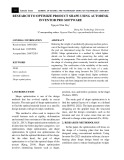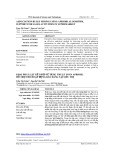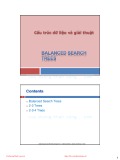
Lab 15
Review of Arrays, Array of Objects and Vector
Dr. John Abraham, Professor
I have noticed over the years that students have great deal of difficulty
dealing with composite and abstract data types. Therefore we are going
spend an extra lab review material we have already learned. Vector data
type, a variation of array, will be introduced as well. Vector data type
(Vector Class) can be used when you need an array that grows dynamically.
However, C++ does not allow us to declare size of an array dynamically
like some other languages. It is important for you to declare the maximum
size you will need. Suppose you are writing a program to keep grades. You
have to predict the maximum class size you will have. At our university,
UTPA, in computer science department we will not have more than 150
students. Most of our classrooms can only hold less than 100 students. So it
would appropriate to declare an array size of 150, if you are writing a
program to keep grades.
When you declare an array, declare it for the maximum size you will
ever need. But, keep track of how many of array elements that were used.
The remaining elements are assumed to have random values (garbage).
Students often forget to keep the count of actual elements used in an array.
So, when you pass an array, make it a practice to pass the array along with
the number of elements used. A sentinel value is used to mark the end of
valid elements. For example, if you are keeping grades: 88 78 77 99 100 68
87 67 89 -1; the -1 is the sentinel value. Even though 10 values are entered
including -1, only 9 valid numbers are entered.
You can populate an array various ways. The simplest is to assign a
value to each of the locations such as:
grades[0]=88;
grades[1]=78;
grades[2]=77;
Alternatively, you may read these grades in:
cin >> grades[0];
cin >> grades[1];
cin >> grades[2];
It would be easier to read the values in a loop:
For (i=1; i<=8; i++) cin >> grades[i];

For loop can only used if you know how many values we are dealing with.
If you want to read an unknown number of values and stop reading when a
sentinel value is entered, the while loop or do while loop should be used.
In the following program 15-1, we have grades[] and n to keep track
of the array and the number of actual grades. Pay particular attention to
passing of an array. Declaring a function with array parameters is similar to
function with simple data types except to include the [], to indicate the array.
Let us look at the function getGrades. It returns the number of actual grades
entered (does not count the sentinel value entered). The function receives a
parameter, int grades[]. When an array is passed, a pointer to the memory
where the first element of the array can be found, is passed. Do not pass
arrays as reference parameter, like int& grades[]. When this function is
called in the main, n=getGrades(grades), the number of grades is received
into n; note that the argument is grades, not grades[]. Once an array is
declared, use its name and the compiler is aware that it is an array. When
we display the grades both the array and the number of grades are passed.
Program 15-1
/*************************************************
Read into an Array
By Dr. John Abraham
Created for 1370 students
**************************************************/
#include <iostream>
using namespace std;
int getGrades (int grades[]);
void displayGrades(int grades[], int);
//--------------main------------------------------------
int main ()
{
int grades[150];
int n; // number of scores read excluding negative number.
n = getGrades(grades); //go get the scores and how many
cout <<"\nHere are the scores entered:\n";
displayGrades(grades,n);
return(0);
}
//--------------function getscores----------------------
int getGrades(int grades[])
{
int n=1;
cout << "ENTER A SCORE AND PRESS ENTER. YOU QUIT ANY TIME BY
ENTERING A NEG NUMBER!\n";

cout << "Enter score# " << n << " ";
cin >> grades[n];
while (grades[n] >= 0)
{
n++;
cout << "Enter score# " << n <<" ";
cin >> grades[n];
}
return n-1; //n-1 actual scores read (ignore negative score).
}
//-------------function display scores------------------
void displayGrades(int grades[], int n)
{
int i;
for (i=1; i<=n; i++)
cout << grades[i] <<endl;
}
Now that I have discussed reading into an array, we will turn to processing
elements in an array. For this I refer you to the standard deviation program where we
work with three arrays, one to store the data, the second one to find the difference of each
score from the mean and the third one to find store the square of deviation of each score.
The mean is calculated by adding all valid scores stored in the array and dividing by the
number of scores. The deviation of each score is obtained by subtracting the score from
the mean. Since this program drills you in array processing, I would ask all students to
know this program thoroughly. Standard deviation is calculated using the following
formula:
Lower case sigma means 'standard deviation'.
Capital sigma means 'the sum of'.
x bar means 'the mean'
Program 15-2
/*************************************************
Read scores from a file into an array.
Keep track of number of scores entered.



















![Hệ thống quản lý cửa hàng bán thức ăn nhanh: Bài tập lớn [chuẩn nhất]](https://cdn.tailieu.vn/images/document/thumbnail/2025/20251112/nguyenhuan6724@gmail.com/135x160/54361762936114.jpg)
![Bộ câu hỏi trắc nghiệm Nhập môn Công nghệ phần mềm [mới nhất]](https://cdn.tailieu.vn/images/document/thumbnail/2025/20251111/nguyenhoangkhang07207@gmail.com/135x160/20831762916734.jpg)





